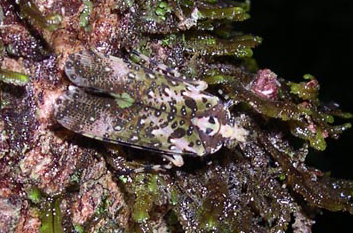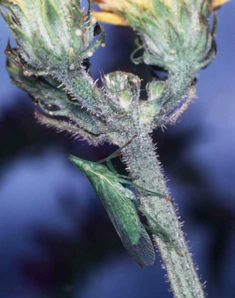 |
|                  |    |  | ||||
| | ||||||||
| Origin Within the Hemiptera, the Fulgoromorpha (which include some crop pests of major economic importance) belong to a very diversified and biologicaly differenciated group, present in every major biogeographical areas. More over, obligatory phytophagous, they interact also strongly with plants at any time of their life cycle and activities. Planthoppers provide a relevant framework for research in evolutionary biology, particularly in ecology, biogeograhy and ethology. This make planthoppers an interesting model for a better understanding of origin, structure and development of biodiversity and its conservation.
While capturing what is being done, the objectives of the FLOW Project are to preserve, to organize and to give access to the taxonomic expertise already acquired, and to facilitate and to promote fundamental or applied researches in Fulgoromorpha in the fields of Biodiversity and Conservation management. |  |
 | Presentation FLOW is an on-line database that aims to provide an easy-access synthesys of available biological published primary data on planthoppers (Hemiptera, Fulgoromorpha), a group of major economic importance. It includes information on taxonomy, nomenclature, type depository, bibliography, distribution and various associated biological information as host-plants, parasites of planthoppers of the world including fossiles. Ultimately it will include also photos of types and biotopes, sound recording and molecular data for more than 14000 species currently described. FLOW is a contribution to BEFRI (Biodiversity and Evolution of Fulgoromorpha: a Research Initiative). |
| Technical realization This database has been realized with table-structured data, through PostGreSQL. The main originality of the new version of FLOW (v.3 and following) is that names and taxa in the conceptual schem (DBTNT) are treated separately to allow independent management of subjective taxonomic and objective nomenclatural aspects (Gallut C. et al., 2005a & 2005b, Final Workshop Species 2000, 14th Oct. 2005, Stockholm, Sueden). Pages are structured in a semantic network that permits an easy access to different information with a dynamic access to data.
Computerized tools (ERC, DB2WEB, DBTNT, TaxaLife) used in this project are not specific to FLOW but easily adaptable for any taxonomic group. For instance, similar databases already exist for sandflies (Diptera, Psychodidae: CIPA project), for froghoppers (Hemiptera Cercopoidea: COOL project) or jumping plant lice (Hemiptera Psylloidea: Psyl'list project). |  |
| Community The FLOW project was initiated in 1996 by Thierry Bourgoin with the help of Jacques Lebbe and his team. Since, many people have been involved at some time providing new version for each major revision of the database. Most are still now in the project. I hope I will forget no one: - Specific data processing credits: Jacques Lebbe and Régine Vigne-Lebbe (DB2Web, version1), Guillaume Rousse (OSIS, version 2), Cyril Gallut (DBTNT, version 3), Angel Anta (Editor, Translator, and Explorer moduls, and many smaller but essential issues), Aurélien Odent (TaxaLife), Nicolas Lebbe (Taxa name history graphical implementation) and Florian Lafosse-Marin (autotexts). Most modificationas since 2004 were developed by Angel Anta. - Photo credits: Marc Attié, Michel Boulard, René Sforza, Gernot Kunz. - Entering data: Sheryl and John Kenneth Yap (Los Baños Laguna Philippines), Pedro Alvarez, Pascale Bezard-Falgas. - Translation of the website in Chinese: Rong-Rong Wang. - First taxonomic data synthesis: Paula Cavalcanti Ceotto (Cixiidae), Fabrice Lefebvre (Fossils), Adeline Soulier-Perkins (Lophopidae), Jacek Swezdo (Fossils), Vladimir Gnezdilov (Caliscelidae), Rong-Rong Wang (Tropiduchidae) ... |
| Contribution & citation Contact Thierry Bourgoin for more details: any complementary information/data and correction are welcome, but only published ones can be considered.
How to cite FLOW? Bourgoin Th. 2019. FLOW (Fulgoromorpha Lists on The Web): a world knowledge base dedicated to Fulgoromorpha. Version 8, updated [date]. http://www.hemiptera-databases.org/flow/ |
| General standards and thesaurus used in FLOW
Introduction Technical standards and accepted thesaurus are fundamental to exchange data in the new digital space in which biodiversity research is now evolving. They are numerous and concern all levels of information from IT perspectives to elaborated knowledge concept (and first of all in the field of biodiversity, the status of a taxon specially). Their publication by each biodiversity database should be recommanded in order to accelerate their use and recognition within and outside the biodiversity community. DBTNT family databases - as FLOW - follow the GBIF Vocabularies and the Darwin Core Vocabularies (published by Markus Döring, 08/03/2009). The Darwin Core (DwC) has been ratifief and is the recommended standard to be used by the TDWG (Biodiversity Information Standards). It describes the minimum set of standards for search and retrieval of natural history collections and observation databases. The Darwin Core and its extensions are based on the ABCD (Access to Biological Collection Data) standards and on internationally recognized standards (e.g. ISO and TDWG). 1.Taxonomic status Compatible with the Darwin Core Vocabularies for taxonomic status. 2. Nomenclatural code Follows ICZN code (International Code of Zoological Nomenclature). 3. Taxon rank status Follows the Darwin Core Vocabularies for the taxon rank. 4. Occurrence status When stated it follows the Darwin Core Vocabularies for the occurrence status. 5. Establisment Means status When stated it follows the Darwin Core Vocabularies for the establishment means status. 6. IUCN threat status Not yet registered in DBTNT family databases. When it will be, it will follow the IUCN red list of Threatened Species categories as recommended by the Darwin Core Vocabularies. 7. IUCN Habitat types Not yet registered in DBTNT family databases. When it will be, it will follows the types proposed by the Darwin Core Vocabularies for IUCN habitats types. 8. Distribution standards FLOW follows the TDWG standard 'World Geographical Scheme for Recording Plant Distributions levels 3 and 4 that documents species distribution at the countries level. There is no available standard for biogeographical regions. In some cases, level 4 data has been subdivided in a lower level (to take into account island distribution for instance). Distribution maps are generated using the EDIT Map REST services. 9. Geological time scale Follows the 2017 standard (dates and nomenclature) of the International Commission on Stratigraphy. 10. Host-plants Taxonomy and botanical classification For accepted names of botanical species, FLOW do not necessarily follows the taxonomic name provided with the linked reference but it refers to the TROPICOS database for all of the nomenclatural, bibliographic, and plant classification as provided by the Missouri Botanical Garden, 4344 Shaw Boulevard, Saint Louis, Missouri 63110, USA. If the taxonomic status names is not provided by TROPICOS (e.g. no accepted name), FLOW follows the Species 2000 Catalogue of Life annual checklist. Ultimately, if no match, the name registered will be the one provided by the reference cited. 11. Hemiptera supra familial classification FLOW follows HemClas, the suprafamilal Hemiptera classification updated from (Bourgoin Th., J. Swzedo & F. Lefèbvre, 2004. About Hemiptera phylogeny and Classification, :11-36. In: Fossil Planthoppers (Hemiptera: Fulgoromorpha) of the world. An annotated catalogue with notes on Hemiptera classification. Swzedo, J., Th. Bourgoin & F. Lefèbvre. J. Swzedo edt., Warsaw 2004, 199 pp + 8 pl). HemClas is available in HemBase, the MNHN-Paris Hemiptera database package. 12. Species and Peer-review FLOW is based on the Metcalf catalogues for the Fulgoromorpha which have been updated. Resources for litterature follows basically these catalogues also available at the Dr Metcalf website. FLOW has been peer reviewed (2007, 2012) by the Species 2000 and ITIS Consortium and accepted as provider for the planthoppers (Hemiptera, Fulgoromorpha) referenced names and taxa in the Catologue of Life. The Catalogue of Life serves as the taxonomic backbone (or the standard for valid species!) for various global initiatives as the GBIF, EoL (Encyplopedy of Life), GenBank, CBoL (Consortium for the Barcode of Life), … 13. Collection coding Depositories of type specimen follows the BCI index (Biodiversity Collection Index) which unambiguously references collections. Data are collected from the original paper or, when available, from more updated referenced sources. |
We are very please to thank them:
- Altoé Falqueto Silvia (Cuiabá, Brazil)
- Alvarez Pedro (Paris, France)
- Anta Angel (Paris, France)
- Anufriev Georgy (Nizhny Novgorod, Russia)
- Asche Manfred (Berlin, Germany)
- Attié Marc (Reunion Island, France)
- Bartlett Charles (Newark, Delaware, USA)
- Bezard-Falgas Pascale (Paris, France)
- Boulard Michel (Paris, France)
- Capricho Ariel (Los Baños, Laguna, Philippines)
- Ceotto Cavalcanti Paula (Paris, France)
- Constant Jérome (Brussels, Belgium)
- De Haas Marco (Leiden, Netherlands)
- Dehalleux Axel (Paris, France)
- Ducasse Elodie (Paris, France)
- Gallut Cyril (Paris, France)
- Gnezdilov Vladimir (St. Petersburg, Russia)
- Goemans Geert (Belgium)
- Hoch Hannelore (Berlin, Germany)
- Kunz Gernot (Graz, Austria)
- Lafosse-Marin Florian (Paris, France)
- Laupin-Vinatier Alain (Paris, France)
- Le Cesne Maxime (Paris, France)
- Lebbe Jacques (Paris, France)
- Lebbe Nicolas (Paris, France)
- Lefebvre Fabrice (Paris, France)
- Mothiron Nicolas (Paris, France)
- O'Brien Lois (Green Valley, Arizona, USA)
- Odent Aurélien (Paris, France)
- Rousse Guillaume (Paris, France)
- Sforza René (Montpellier, France)
- Soulier-Perkins Adeline (Paris, France)
- Swezdo Jacek (Warszawa, Poland)
- Theeten Franck (Brussels, Belgium)
- Vigne-Lebbe Régine (Paris, France)
- Wang Meng-Lin (Yangling, China)
- Wang Rong-Rong (Beijing, China)
- Wilson Mike (Cardiff, UK)
- Yap Sheryl (Los Baños, Laguna, Philippines)
- Yap John Kenneth (Los Baños, Laguna, Philippines)
|
|
|
|
| |||




